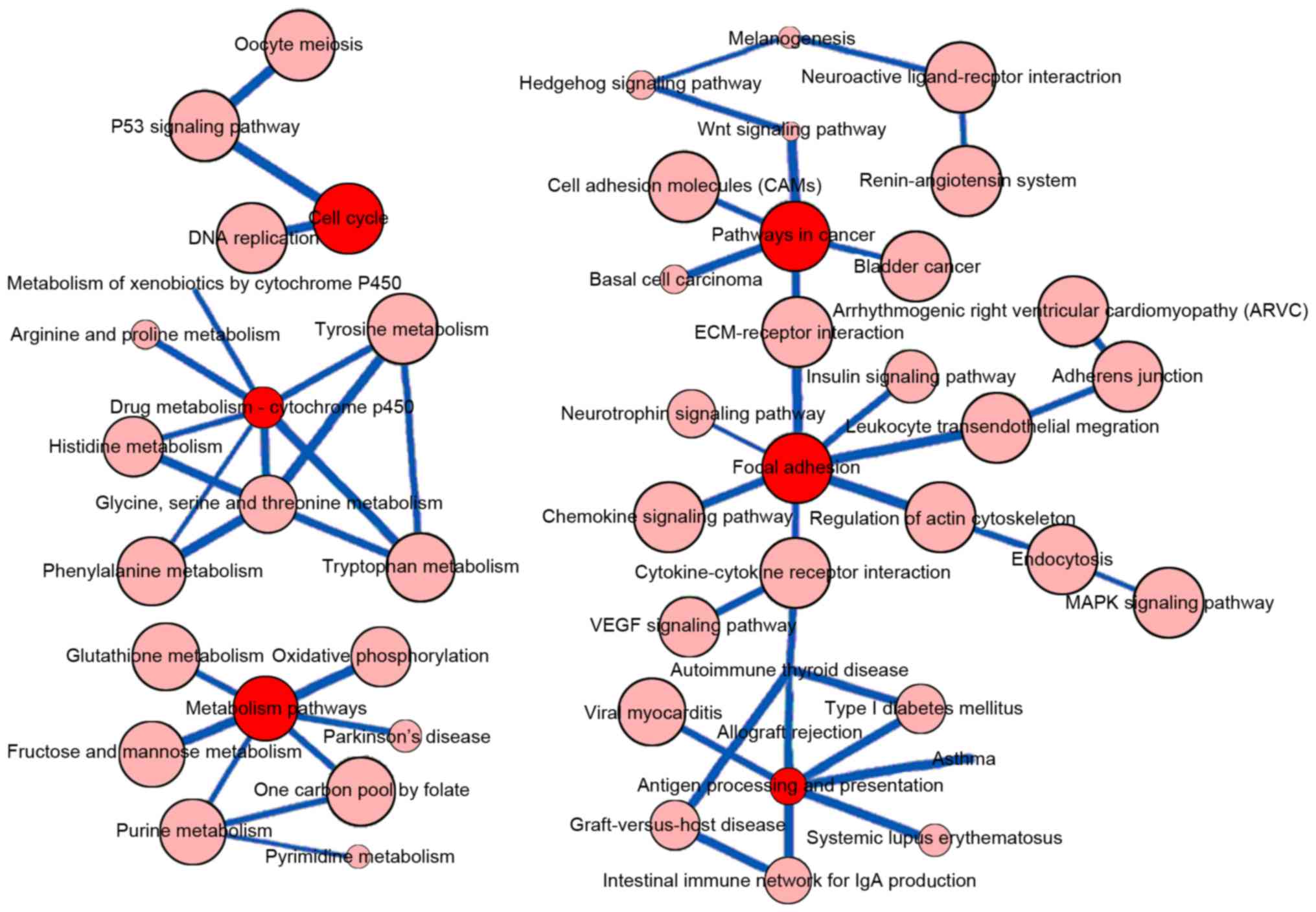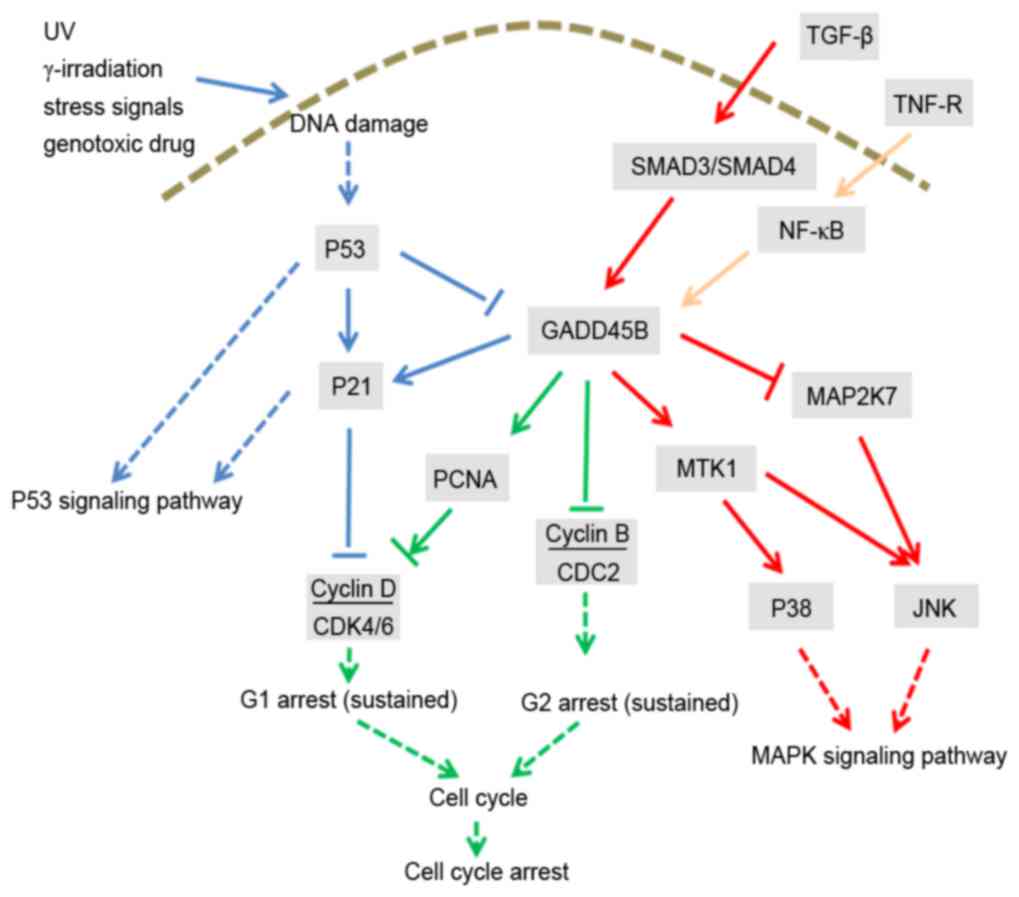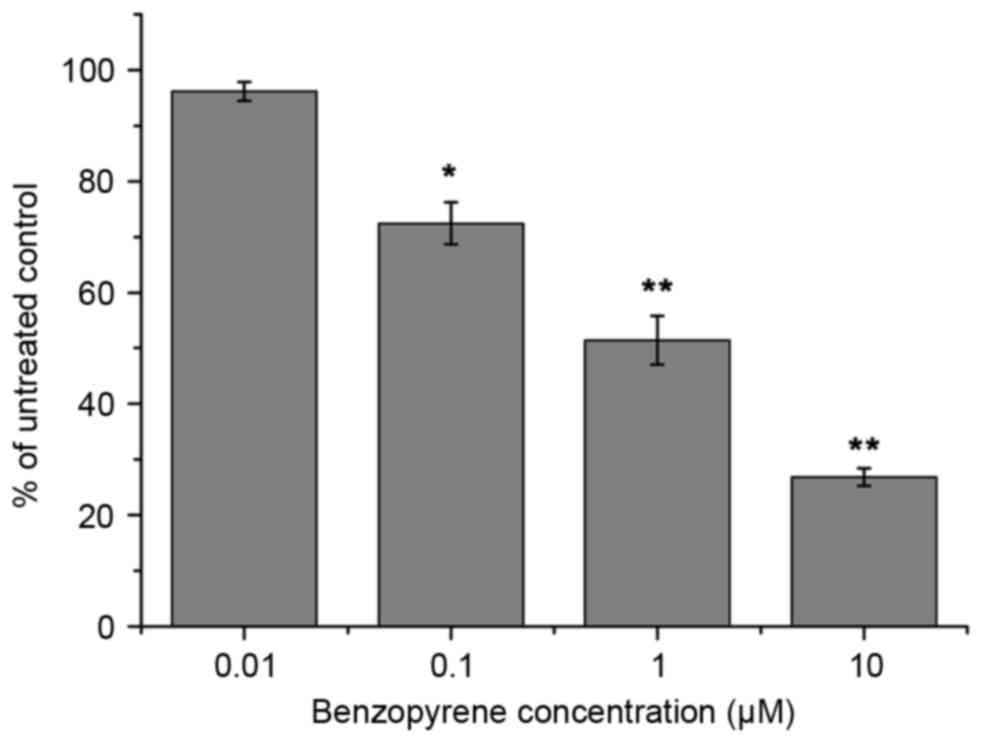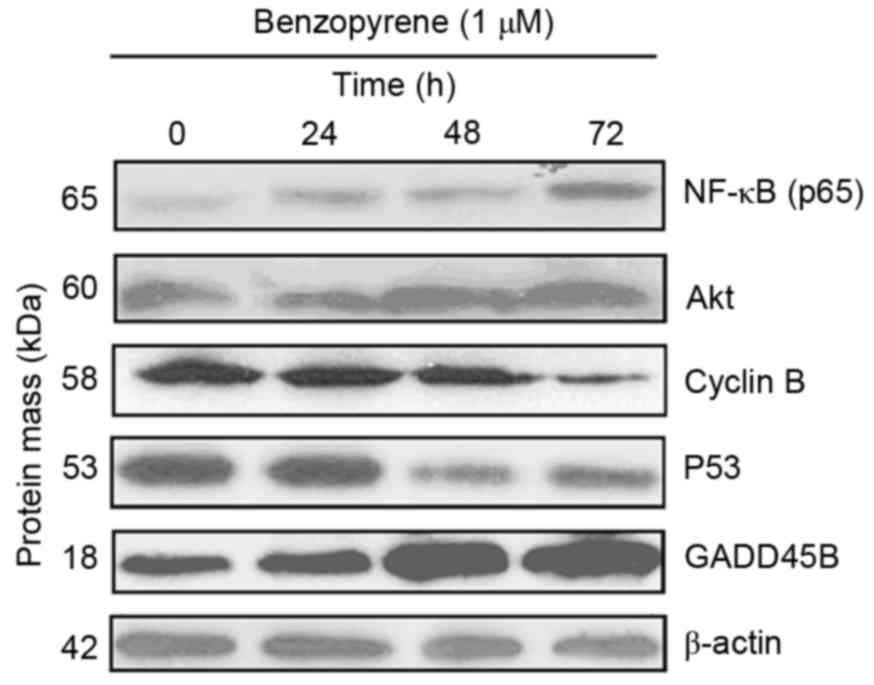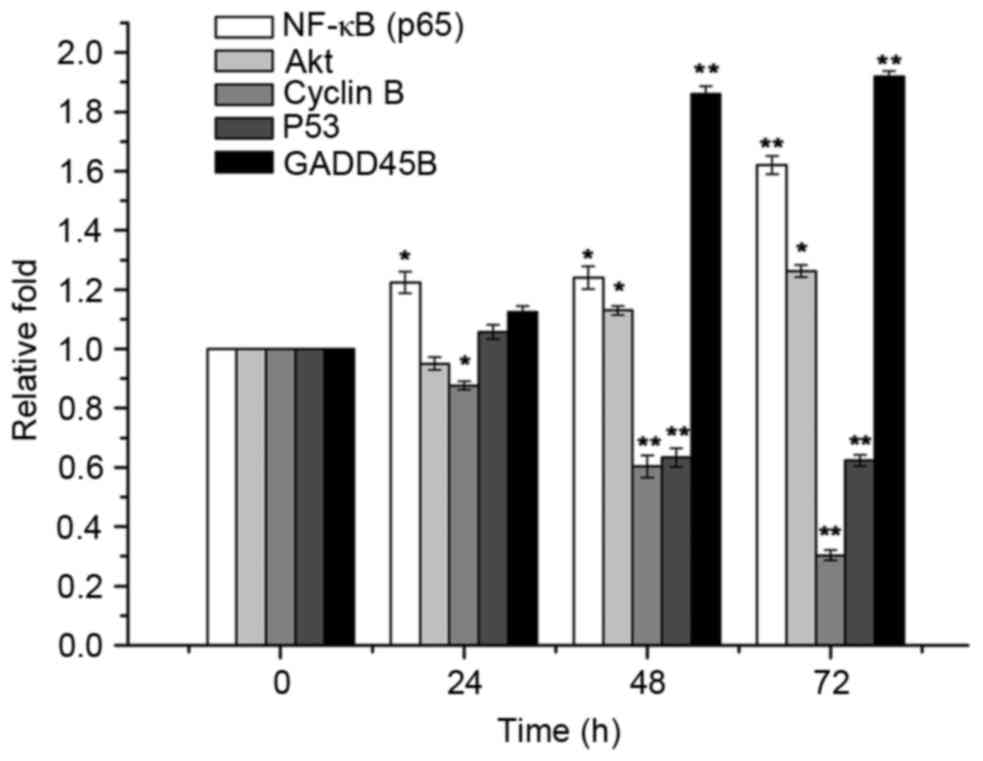|
1
|
McGuire S: World cancer report 2014.
Geneva, switzerland: World health organization, international
agency for research on cancer, WHO Press, 2015. Adv Nutr.
7:418–419. 2016. View Article : Google Scholar : PubMed/NCBI
|
|
2
|
Travis WD, Travis LB and Devesa SS: Lung
cancer. Cancer. 75 Suppl 1:S191–S202. 1995. View Article : Google Scholar
|
|
3
|
Ahrendt SA, Decker PA, Alawi EA, Zhu Yr
YR, Sanchez-Cespedes M, Yang SC, Haasler GB, Kajdacsy-Balla A,
Demeure MJ and Sidransky D: Cigarette smoking is strongly
associated with mutation of the K-ras gene in patients with primary
adenocarcinoma of the lung. Cancer. 92:1525–1530. 2001. View Article : Google Scholar : PubMed/NCBI
|
|
4
|
Naoki K, Chen TH, Richards WG, Sugarbaker
DJ and Meyerson M: Missense mutations of the BRAF gene in human
lung adenocarcinoma. Cancer Res. 62:7001–7003. 2002.PubMed/NCBI
|
|
5
|
Weir BA, Woo MS, Getz G, Perner S, Ding L,
Beroukhim R, Lin WM, Province MA, Kraja A, Johnson LA, et al:
Characterizing the cancer genome in lung adenocarcinoma. Nature.
450:893–898. 2007. View Article : Google Scholar : PubMed/NCBI
|
|
6
|
Engels EA, Wu X, Gu J, Dong Q, Liu J and
Spitz MR: Systematic evaluation of genetic variants in the
inflammation pathway and risk of lung cancer. Cancer Res.
67:6520–6527. 2007. View Article : Google Scholar : PubMed/NCBI
|
|
7
|
Wenzlaff AS, Cote ML, Bock CH, Land SJ,
Santer SK, Schwartz DR and Schwartz AG: CYP1A1 and CYP1B1
polymorphisms and risk of lung cancer among never smokers: A
population-based study. Carcinogenesis. 26:2207–2212. 2005.
View Article : Google Scholar : PubMed/NCBI
|
|
8
|
Lin Z, Zhang X, Tuo J, Guo Y, Green B,
Chan CC, Tan W, Huang Y, Ling W, Kadlubar FF, et al: A variant of
the Cockayne syndrome B gene ERCC6 confers risk of lung cancer. Hum
Mutat. 29:113–122. 2008. View Article : Google Scholar : PubMed/NCBI
|
|
9
|
Amos CI, Wu X, Broderick P, Gorlov IP, Gu
J, Eisen T, Dong Q, Zhang Q, Gu X, Vijayakrishnan J, et al:
Genome-wide association scan of tag SNPs identifies a
susceptibility locus for lung cancer at 15q25.1. Nat Genet.
40:616–622. 2008. View
Article : Google Scholar : PubMed/NCBI
|
|
10
|
Westhoff B, Colaluca IN, D'Ario G,
Donzelli M, Tosoni D, Volorio S, Pelosi G, Spaggiari L, Mazzarol G,
Viale G, et al: Alterations of the Notch pathway in lung cancer.
Proc Natl Acad Sci USA. 106:pp. 22293–22298. 2009; View Article : Google Scholar : PubMed/NCBI
|
|
11
|
Leidner RS, Fu P, Clifford B, Hamdan A,
Jin C, Eisenberg R, Boggon TJ, Skokan M, Franklin WA, Cappuzzo F,
et al: Genetic abnormalities of the EGFR pathway in African
American Patients with non-small-cell lung cancer. J Clin Oncol.
27:5620–5626. 2009. View Article : Google Scholar : PubMed/NCBI
|
|
12
|
Gustafson AM, Soldi R, Anderlind C,
Scholand MB, Qian J, Zhang X, Cooper K, Walker D, McWilliams A, Liu
G, et al: Airway PI3K pathway activation is an early and reversible
event in lung cancer development. Sci Transl Med. 2:26ra252010.
View Article : Google Scholar : PubMed/NCBI
|
|
13
|
Jung IL, Kang HJ, Kim KC and Kim IG:
PTEN/pAkt/p53 signaling pathway correlates with the radioresponse
of non-small cell lung cancer. Int J Mol Med. 25:517–523.
2010.PubMed/NCBI
|
|
14
|
Ding L, Getz G, Wheeler DA, Mardis ER,
McLellan MD, Cibulskis K, Sougnez C, Greulich H, Muzny DM, Morgan
MB, et al: Somatic mutations affect key pathways in lung
adenocarcinoma. Nature. 455:1069–1075. 2008. View Article : Google Scholar : PubMed/NCBI
|
|
15
|
Bremnes RM, Veve R, Gabrielson E, Hirsch
FR, Baron A, Bemis L, Gemmill RM, Drabkin HA and Franklin WA:
High-throughput tissue microarray analysis used to evaluate biology
and prognostic significance of the E-cadherin pathway in
non-small-cell lung cancer. J Clin Oncol. 20:2417–2428. 2002.
View Article : Google Scholar : PubMed/NCBI
|
|
16
|
Yanaihara N, Caplen N, Bowman E, Seike M,
Kumamoto K, Yi M, Stephens RM, Okamoto A, Yokota J, Tanaka T, et
al: Unique microRNA molecular profiles in lung cancer diagnosis and
prognosis. Cancer Cell. 9:189–198. 2006. View Article : Google Scholar : PubMed/NCBI
|
|
17
|
Liu XG, Zhu WY, Huang YY, Ma LN, Zhou SQ,
Wang YK, Zeng F, Zhou JH and Zhang YK: High expression of serum
miR-21 and tumor miR-200c associated with poor prognosis in
patients with lung cancer. Med Oncol. 29:618–626. 2012. View Article : Google Scholar : PubMed/NCBI
|
|
18
|
Landi MT, Dracheva T, Rotunno M, Figueroa
JD, Liu H, Dasgupta A, Mann FE, Fukuoka J, Hames M, Bergen AW, et
al: Gene expression signature of cigarette smoking and its role in
lung adenocarcinoma development and survival. PLoS One.
3:e16512008. View Article : Google Scholar : PubMed/NCBI
|
|
19
|
Ogata H, Goto S, Sato K, Fujibuchi W, Bono
H and Kanehisa M: KEGG: Kyoto encyclopedia of genes and genomes.
Nucleic Acids Res. 27:29–34. 1999. View Article : Google Scholar : PubMed/NCBI
|
|
20
|
Joshi-Tope G, Gillespie M, Vastrik I,
D'Eustachio P, Schmidt E, de Bono B, Jassal B, Gopinath GR, Wu GR,
Matthews L, et al: Reactome: A knowledgebase of biological
pathways. Nucleic Acids Res. 33:D428–D432. 2005. View Article : Google Scholar : PubMed/NCBI
|
|
21
|
Gautier L, Cope L, Bolstad BM and Irizarry
RA: Affy-analysis of Affymetrix GeneChip data at the probe level.
Bioinformatics. 20:307–315. 2004. View Article : Google Scholar : PubMed/NCBI
|
|
22
|
Górecki T and Smaga Ł: A comparison of
tests for the one-way ANOVA problem for functional data.
Computational Statistics. 30:987–1010. 2015. View Article : Google Scholar
|
|
23
|
Benjamini Y and Hochberg Y: Controlling
the false discovery rate: A practical and powerful approach to
multiple testing. J Royal Statistical Society. Series B
(Methodological). 1–300. 1995.
|
|
24
|
Draghici S, Khatri P, Tarca AL, Amin K,
Done A, Voichita C, Georgescu C and Romero R: A systems biology
approach for pathway level analysis. Genome Res. 17:1537–1545.
2007. View Article : Google Scholar : PubMed/NCBI
|
|
25
|
Francesconi M, Remondini D, Neretti N,
Sedivy JM, Cooper LN, Verondini E, Milanesi L and Castellani G:
Reconstructing networks of pathways via significance analysis of
their intersections. BMC Bioinformatics. 9 Suppl 4:S92008.
View Article : Google Scholar : PubMed/NCBI
|
|
26
|
Tarca AL, Draghici S, Khatri P, Hassan SS,
Mittal P, Kim JS, Kim CJ, Kusanovic JP and Romero R: A novel
signaling pathway impact analysis. Bioinformatics. 25:75–82. 2009.
View Article : Google Scholar : PubMed/NCBI
|
|
27
|
Zhong G, Chen X, Fang X, Wang D, Xie M and
Chen Q: Fra-1 is upregulated in lung cancer tissues and inhibits
the apoptosis of lung cancer cells by the P53 signaling pathway.
Oncol Rep. 35:447–453. 2016. View Article : Google Scholar : PubMed/NCBI
|
|
28
|
Havel LS, Kline ER, Salgueiro AM and
Marcus AI: Vimentin regulates lung cancer cell adhesion through a
VAV2-Rac1 pathway to control focal adhesion kinase activity.
Oncogene. 34:1979–1990. 2015. View Article : Google Scholar : PubMed/NCBI
|
|
29
|
Corrales L, Ajona D, Rafail S, Lasarte JJ,
Riezu-Boj JI, Lambris JD, Rouzaut A, Pajares MJ, Montuenga LM and
Pio R: Anaphylatoxin C5a creates a favorable microenvironment for
lung cancer progression. J Immunol. 189:4674–4683. 2012. View Article : Google Scholar : PubMed/NCBI
|
|
30
|
Pappot H, Pedersen AN, Brünner N and
Christensen IJ: The complex between urokinase (uPA) and its type-1
inhibitor (PAI-1) in pulmonary adenocarcinoma: Relation to
prognosis. Lung Cancer. 51:193–200. 2006. View Article : Google Scholar : PubMed/NCBI
|
|
31
|
McVey JH: Tissue factor pathway.
Baillieres Best Pract Res Clin Haematol. 12:361–372. 1999.
View Article : Google Scholar : PubMed/NCBI
|
|
32
|
Currie MS, Vala M, Pisetsky DS, Greenberg
CS, Crawford J and Cohen HJ: Correlation between erythrocyte CR1
reduction and other blood proteinase markers in patients with
malignant and inflammatory disorders. Blood. 75:1699–1704.
1990.PubMed/NCBI
|
|
33
|
Borensztajn K, Peppelenbosch MP and Spek
CA: Coagulation Factor Xa inhibits cancer cell migration via
LIMK1-mediated cofilin inactivation. Thromb Res. 125:e323–e328.
2010. View Article : Google Scholar : PubMed/NCBI
|
|
34
|
Fan TW, Lane AN, Higashi RM, Farag MA, Gao
H, Bousamra M and Miller DM: Altered regulation of metabolic
pathways in human lung cancer discerned by (13)C stable
isotope-resolved metabolomics (SIRM). Mol Cancer. 8:412009.
View Article : Google Scholar : PubMed/NCBI
|
|
35
|
Koukourakis MI, Giatromanolaki A and
Sivridis E; Tumour and Angiogenesis Research Group, : Lactate
dehydrogenase isoenzymes 1 and 5: Differential expression by
neoplastic and stromal cells in non-small cell lung cancer and
other epithelial malignant tumors. Tumor Biol. 24:199–202. 2003.
View Article : Google Scholar
|
|
36
|
Koukourakis MI, Giatromanolaki A, Sivridis
E, Gatter KC and Harris AL; Tumor and Angiogenesis Research Group,
: Pyruvate dehydrogenase and pyruvate dehydrogenase kinase
expression in non small cell lung cancer and tumor-associated
stroma. Neoplasia. 7:1–6. 2005. View Article : Google Scholar : PubMed/NCBI
|
|
37
|
Yang P, Ebbert JO, Sun Z and Weinshilboum
RM: Role of the glutathione metabolic pathway in lung cancer
treatment and prognosis: A review. J Clin Oncol. 24:1761–1769.
2006. View Article : Google Scholar : PubMed/NCBI
|
|
38
|
Zanger UM, Turpeinen M, Klein K and Schwab
M: Functional pharmacogenetics/genomics of human cytochromes P450
involved in drug biotransformation. Anal Bioanal Chem.
392:1093–1108. 2008. View Article : Google Scholar : PubMed/NCBI
|
|
39
|
Tamura RE, de Vasconcellos JF, Sarkar D,
Libermann TA, Fisher PB and Zerbini LF: GADD45 proteins: Central
players in tumorigenesis. Curr Mol Med. 12:634–651. 2012.
View Article : Google Scholar : PubMed/NCBI
|
|
40
|
Moskalev AA, Smit-McBride Z, Shaposhnikov
MV, Plyusnina EN, Zhavoronkov A, Budovsky A, Tacutu R and Fraifeld
VE: Gadd45 proteins: Relevance to aging, longevity and age-related
pathologies. Ageing Res Rev. 11:51–66. 2012. View Article : Google Scholar : PubMed/NCBI
|
|
41
|
Azam N, Vairapandi M, Zhang W, Hoffman B
and Liebermann DA: Interaction of CR6 (GADD45gamma) with
proliferating cell nuclear antigen impedes negative growth control.
J Biol Chem. 276:2766–2774. 2001. View Article : Google Scholar : PubMed/NCBI
|
|
42
|
Hosokawa S, Toyooka S, Fujiwara Y, Tokumo
M, Soh J, Takigawa N, Hotta K, Yoshino T, Date H, Tanimoto M and
Kiura K: Comprehensive analysis of EGFR signaling pathways in
Japanese patients with non-small cell lung cancer. Lung Cancer.
66:107–113. 2009. View Article : Google Scholar : PubMed/NCBI
|
|
43
|
Gupta M, Gupta SK, Hoffman B and
Liebermann DA: Gadd45a and Gadd45b protect hematopoietic cells from
UV-induced apoptosis via distinct signaling pathways, including p38
activation and JNK inhibition. J Biol Chem. 281:17552–17558. 2006.
View Article : Google Scholar : PubMed/NCBI
|
|
44
|
Takekawa M, Tatebayashi K, Itoh F, Adachi
M, Imai K and Saito H: Smad-dependent GADD45beta expression
mediates delayed activation of p38 MAP kinase by TGF-beta. EMBO J.
21:6473–6482. 2002. View Article : Google Scholar : PubMed/NCBI
|
|
45
|
Macias MJ, Martin-Malpartida P and
Massagué J: Structural determinants of Smad function in TGF-β
signaling. Trends Biochem Sci. 40:296–308. 2015. View Article : Google Scholar : PubMed/NCBI
|
|
46
|
Howley BV, Hussey GS, Link LA and Howe PH:
Translational regulation of Inhibin βA by TGFβ via the RNA-binding
protein hnRNP E1 enhances the invasiveness of
epithelial-to-mesenchymal transitioned cells. Oncogene.
35:1725–1735. 2016. View Article : Google Scholar : PubMed/NCBI
|
|
47
|
Major MB and Jones DA: Identification of a
gadd45beta 3′enhancer that mediates SMAD3- and SMAD4-dependent
transcriptional induction by transforming growth factor beta. J
Biol Chem. 279:5278–5287. 2004. View Article : Google Scholar : PubMed/NCBI
|
|
48
|
Vairapandi M, Balliet AG, Hoffman B and
Liebermann DA: GADD45b and GADD45g are cdc2/cyclinB1 kinase
inhibitors with a role in S and G2/M cell cycle checkpoints induced
by genotoxic stress. J Cell Physiol. 192:327–338. 2002. View Article : Google Scholar : PubMed/NCBI
|
|
49
|
Mi Q, Kim S, Hwang BY, Su BN, Chai H,
Arbieva ZH, Kinghorn AD and Swanson SM: Silvestrol regulates G2/M
checkpoint genes independent of p53 activity. Anticancer Res.
26:3349–3356. 2006.PubMed/NCBI
|
|
50
|
Zhan Q: Gadd45a, a p53-and BRCA1-regulated
stress protein, in cellular response to DNA damage. Mutat Res.
569:133–143. 2005. View Article : Google Scholar : PubMed/NCBI
|
|
51
|
Lambert JM, Moshfegh A, Hainaut P, Wiman
KG and Bykov VJ: Mutant p53 reactivation by PRIMA-1MET induces
multiple signaling pathways converging on apoptosis. Oncogene.
29:1329–1338. 2010. View Article : Google Scholar : PubMed/NCBI
|
|
52
|
Denissenko MF, Pao A, Tang M and Pfeifer
GP: Preferential formation of benzo[a]pyrene adducts at lung cancer
mutational hotspots in p53. Science. 274:430–432. 1996. View Article : Google Scholar : PubMed/NCBI
|















